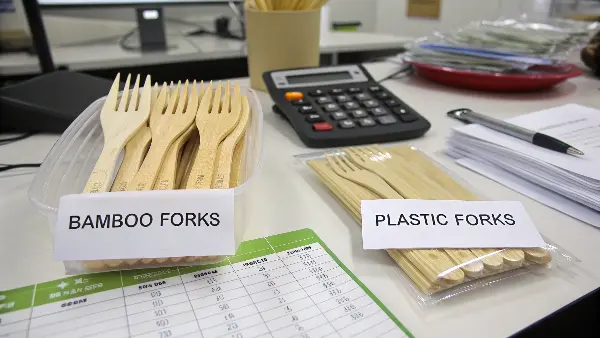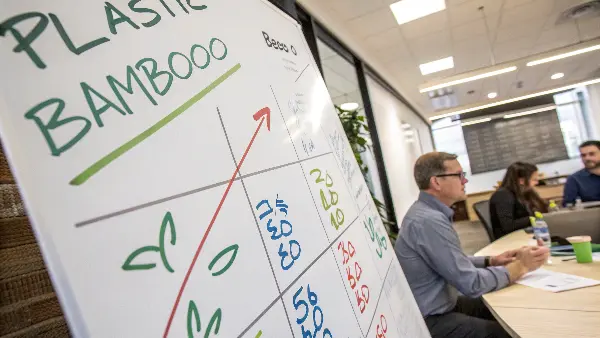Are you feeling the pressure to make your foodservice business more sustainable, but wince every time you look at the cost of eco-friendly alternatives? You know plastic is bad for the planet and your brand, but with tight margins, the switch feels like a financial risk you can’t afford. This guide breaks down the true economics for you.
Switching to bamboo tableware involves more than comparing unit prices with plastic. While bamboo may have a slightly higher initial cost, the total economic impact includes major savings from avoiding plastic taxes, increased customer loyalty leading to higher revenue, and enhanced brand value that attracts new diners. For most modern foodservice businesses, it’s a strategic investment in long-term profitability and market relevance.

I talk to business owners like you every day. They’re all asking the same questions about the bottom line. They want to do the right thing, but they also need to stay profitable. The good news is, these two goals are no longer mutually exclusive. In fact, they are now directly linked. Let’s break down the numbers and see how this investment pays off, moving beyond just the initial price tag.
What’s the real cost difference between bamboo and plastic tableware?
You see the price for a case of bamboo forks and immediately compare it to the plastic ones you’ve always bought. The higher number makes you hesitate, imagining your supply budget expanding and your profits shrinking. But looking only at the per-unit price is like judging a meal by the cost of one ingredient; it doesn’t give you the full picture.
While bamboo tableware often has a higher upfront per-unit cost than single-use plastic, this gap is rapidly closing. Advances in manufacturing and streamlined B2B supply chains are making bamboo more affordable. Meanwhile, volatile oil prices and new "plastic taxes" in many regions are consistently driving up the cost of plastic. A detailed analysis reveals the initial price difference is often much smaller than perceived, especially when purchasing in bulk.

When I first started sourcing sustainable products, the price difference was a major hurdle for my clients. But things have changed dramatically. Let’s look at the factors that influence the direct costs you see on an invoice.
Deconstructing the Unit Price
The final price you pay is a result of the entire supply chain, from raw material to your doorstep.
- Raw Material Costs: Plastic is a petroleum product. Its price is tied directly to the volatile global oil market, making budget forecasting unpredictable. Bamboo, on the other hand, is a fast-growing, renewable grass that can be harvested in 3-5 years without harming the soil. This creates a more stable and predictable raw material cost.
- Manufacturing & Logistics: Manufacturing technology for bamboo products has become incredibly efficient. As a B2B supplier, we work directly with factories that have optimized their processes for large-scale production. This efficiency, combined with streamlined global logistics, helps us deliver high-quality bamboo tableware at a price point that is increasingly competitive with plastic.
The Impact of Volume
A simple cost comparison of a single pack of forks at retail is misleading for a foodservice business. The real economics come into play with bulk purchasing. Below is a simplified table to illustrate the point.
| Factor | Single-Use Plastic | Bamboo Tableware | Economic Impact on Your Business |
|---|---|---|---|
| Per-Unit Cost | Lower, but rising due to taxes/oil prices. | Slightly higher, but stable and decreasing. | The gap is small and often disappears with bulk orders. |
| Cost Stability | Volatile; tied to oil markets. | Highly stable and predictable. | Stable costs make financial planning and budgeting easier. |
| Bulk Discounting | Standard discounts available. | Significant discounts available. | Buying in bulk makes bamboo’s cost nearly parallel to plastic. |
| Government Levies | Subject to increasing plastic taxes and fees. | Often exempt from eco-taxes; may qualify for green subsidies. | An immediate and growing cost advantage for bamboo. |
By partnering with a direct source like Ecosourcecn, you bypass domestic distributors and their markups, accessing wholesale pricing that makes the switch financially viable.
How does the total cost of ownership compare for bamboo vs. plastic?
Focusing only on what you pay per case is a critical mistake. You might be saving a few cents per fork today, but what hidden costs are lurking? You worry about disposal, customer complaints about flimsy plastic, and the looming threat of new regulations that could force a costly, last-minute change. These "invisible" expenses can quickly erase any upfront savings from choosing plastic.
The Total Cost of Ownership (TCO) for bamboo tableware is often significantly lower than for plastic. This is because TCO accounts for hidden expenses associated with plastic, such as waste disposal fees, regulatory non-compliance fines, and the loss of business from eco-conscious customers. Bamboo, being compostable and aligning with green regulations, eliminates these financial risks and transforms a simple expense into a valuable business asset that protects your bottom line.

I once worked with a catering company that was fiercely loyal to cheap plastic cutlery. They believed it was key to their profitability. However, after a city-wide ban on single-use plastics was announced, they had to scramble. They faced inventory write-offs and rushed orders for compliant products at premium prices. Their TCO for plastic suddenly skyrocketed. This is a perfect example of why we must look deeper.
Beyond the Invoice: Calculating the Real Cost
Total Cost of Ownership forces you to consider the entire lifecycle of a product within your operations.
- Disposal Costs: Many municipalities charge businesses more for non-recyclable or contaminated waste. Plastic tableware almost always ends up in a landfill, contributing to higher waste management bills for your business. Commercially compostable bamboo can often be diverted to organics streams, which can be cheaper and sometimes even subsidized.
- Regulatory & Compliance Costs: All over the world—from Canada to the EU and Australia—governments are implementing bans or taxes on single-use plastics. Sticking with plastic means navigating a complex web of regulations that changes constantly. The cost of non-compliance, including fines and potential business interruptions, is a huge financial risk. Choosing a compliant material like bamboo eliminates this risk entirely.
- Reputational Costs: In the age of social media, a single photo of your brand’s plastic waste overflowing from a public bin can cause significant reputational damage. The cost of losing customers who prioritize sustainability is hard to measure but is undeniably massive.
Here’s a breakdown of how these factors add up.
| Cost Factor | Single-Use Plastic | Bamboo Tableware | Unseen Financial Impact |
|---|---|---|---|
| Purchase Price | Low initial cost. | Slightly higher initial cost. | The most visible, but least impactful, part of the TCO. |
| Disposal Fees | Higher; contributes to general landfill waste. | Lower; can be sent to commercial composting facilities. | Direct operational savings on your monthly waste bill. |
| Regulatory Risk | High; subject to bans and accumulating taxes. | Extremely low; aligns with global green initiatives. | Avoids costly fines and forced, rushed operational changes. |
| Brand Damage Risk | High; negative perception from eco-aware customers. | Low; positive perception enhances brand image. | Prevents customer churn and negative online reviews. |
| Customer Lifetime Value | Neutral or negative impact. | Positive impact; attracts and retains loyal customers. | A hidden revenue generator that plastic can’t offer. |
When you add it all up, the "cheaper" plastic option reveals itself to be a financial liability in disguise. The slightly higher initial investment in bamboo tableware is, in reality, an insurance policy against future costs and a driver of long-term value.
Can switching to bamboo actually boost my restaurant’s revenue?
You’ve analyzed the costs, and the switch seems manageable. But can it actually make you more money? The idea of customers paying more or choosing your business specifically because of your tableware might seem far-fetched. You wonder if this is just a trend or a real, measurable driver of business growth that will impact your bottom line.
Yes, switching to bamboo tableware can directly boost your revenue. Studies and market trends consistently show that a growing majority of consumers prefer to buy from sustainable businesses and are often willing to pay a premium for it. By visibly demonstrating your commitment to the environment with high-quality bamboo products, you attract a loyal customer base, increase average spending, and create a powerful marketing advantage that drives sales.

Let me share a story from a client of mine, a popular urban café. They switched from plastic to our branded bamboo cutlery and plates. They placed small signs on their tables explaining the change. Within three months, they reported not only an increase in positive online reviews mentioning their eco-friendly practices but also a 5% rise in their average transaction value. Customers were adding that extra pastry or specialty coffee, feeling good about supporting a business that shared their values.
The Tangible Value of Sustainability
This isn’t just about feeling good; it’s about smart business. The "green" consumer is no longer a niche market. It’s the mainstream.
- Attracting and Retaining the Modern Customer: A 2021 study by Simon-Kucher & Partners found that 71% of consumers globally have changed their purchasing behavior over the past five years to be more sustainable. By using bamboo, you are sending a clear signal that you cater to this majority. These customers are not just numerous; they are also exceptionally loyal.
- Justifying Premium Pricing: High-quality bamboo tableware has a superior feel and aesthetic compared to flimsy plastic. It elevates the dining experience, whether it’s for takeout or a food truck meal. This enhanced perception of quality makes it easier for customers to accept premium pricing. They aren’t just paying for food; they are paying for a better, more responsible experience.
Turning an Operational Choice into a Marketing Engine
Your choice of tableware isn’t just a back-of-house decision. It’s a front-and-center marketing tool.
| Revenue Driver | How Bamboo Contributes | Actionable Tip for Your Business |
|---|---|---|
| Increased Customer Traffic | Attracts eco-conscious diners who actively seek out sustainable businesses. | Mention your "planet-friendly packaging" on your Google Business Profile, Yelp, and social media bios. |
| Higher Average Spend | Customers feel better about their purchase and are more inclined to spend more. | Train staff to mention your sustainability efforts when serving customers. E.g., "Enjoy your meal with our compostable bamboo cutlery!" |
| Enhanced Customer Loyalty | Builds an emotional connection with customers who share your values, leading to repeat business. | Start a simple loyalty program where customers are rewarded for returning their compostable containers for proper disposal. |
| Positive Word-of-Mouth | Gives customers a compelling, positive story to share about your brand online and offline. | Encourage user-generated content by running a social media contest for the best photo featuring your eco-friendly packaging. |
Ultimately, switching to bamboo is not just an expense to be minimized. It is a revenue-generating investment. It differentiates your brand in a crowded market and builds a loyal community of customers who will choose you over competitors, again and again.
Conclusion
The economics are clear: switching from plastic to bamboo tableware is no longer a costly sacrifice for foodservice businesses. It’s a shrew, strategic investment in your financial future. By looking beyond the unit price to the total cost of ownership and the immense potential for revenue growth, the choice becomes obvious. This is your chance to cut hidden costs, attract loyal customers, and build a stronger, more resilient brand.


